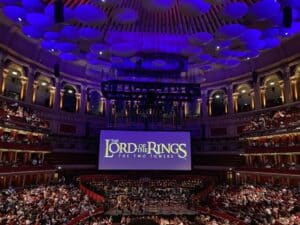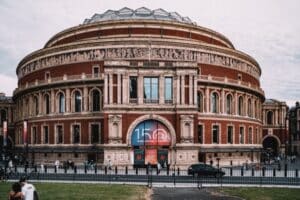It’s hard to top watching a favorite movie like “The Two Towers” with a live soundtrack
I have to confess. I am a Ringhead.
I first read J.R.R. Tolkien’s The Hobbit and The Lord of the Rings trilogy in high school, using what came to be known as the “pirated Ace editions.” I read the authorized versions about six years later. About 2000, when I learned that director Peter Jackson was making film versions, I read the books again. And then, four years ago, I read the books yet again.
These wonderful stories never get old. They never seem dated. Each time I’ve read them, I’ve discovered something new. And I continue to be awed by the imagination that created them.
I’m not alone. Facebook groups about the author and his works draws tens of thousands. Tolkien and his works are subjects of a book-publishing industry. Sitting on my desk right now, in all of its 938-page glory, is the recently published The History of the Hobbit by Tolkien scholar John Rateliff. I’ve deliberately put off reading it to delay the reading pleasure I know is coming.
When The Fellowship of the Ring, the first Peter Jackson movie, appeared in 2001, my wife, my then 14-year-old son, and I sat enraptured. My son and I saw it three more times in the movie theater, a practice we repeated in 2002 with The Two Towers and in 2003 with The Return of the King. We bought and watched the DVD versions. And then we bought and watched the extended DVD versions, which included scenes cut from the movie. A few years ago, my wife and I attended a showing of The Fellowship of the Ring at Powell Symphony Hall in St. Louis, with the soundtrack performed by the St. Louis Symphony Orchestra.
For several years, she and I have made regular vacation visits to England. For various reasons (including COVID-19, knee replacement surgeries, and British transportation strikes), it’s been six years since our last visit. But this year we were going. One place we had never visited but wanted to see was the Royal Albert Hall. And my wife discovered that, during our scheduled visit, one event at the hall was a showing of The Two Towers, with the soundtrack performed live by the London Royal Philharmonic Orchestra.
Yes, I bought tickets, not inexpensive tickets for Grand Tier box seats that were nearly dead center to the screen. We bought them early, and it was a good thing that we did. The event was a sellout. In addition to the Philharmonic Orchestra, the performance included the Philharmonia Chorus and the Trinity Boys Choir. The orchestra conductor was Ludwig Wicki, who recently had been conductor of the St. Louis Symphony.
From our hotel, we rode the Underground (aka The Tube) to the South Kensington station. We followed the signs to walk the below-ground tunnel that channels visitors to the Natural Science Museum, the Victoria & Albert Museum, and the Royal Albert Hall. Exiting on a side street, we made our way to our designated entry door and then up the staircase to the grand tier level. It was crowded and chaotic, with a crowd anticipating something special.

The view of the screen from the Grand Tier
No one would be disappointed. The film, the music and the orchestra, the choirs, the soloists, and the hall itself provided a seamless, and magical, performance.
The audience wasn’t in one of the most famous concert halls in the world; we were in Middle Earth. We were kidnapped by orcs with Merry and Pippin. We were making our way through the swamp with Gollum, Sam, and Frodo. We were in Helm’s Deep with the people of King Theodon. We were trying to fight the Nazgul attack on the city of Gondor. We were marching with the Ents as the ancient trees attacked the domain of Saruman, the traitor wizard. Were were listening to Aragorn and Arwen speak to each other in Elvish.
More than 20 years after its release, there’s nothing dated about The Two Towers. It seems as new as when it was first released in 2002. To watch it is to be reminded that the movie is remarkably true to the book. And to watch it and hear the soundtrack performed in the Royal Albert Hall in London is unforgettable.
Especially for a Ringhead.
Photo by kuhnmi, Creative Commons, via Flickr. Post by Glynn Young.
How to Read a Poem uses images like the mouse, the hive, the switch (from the Billy Collins poem)—to guide readers into new ways of understanding poems. Anthology included.
“I require all our incoming poetry students—in the MFA I direct—to buy and read this book.”
—Jeanetta Calhoun Mish
- Poets and Poems: Sandra Marchetti and “Diorama” - April 24, 2025
- Poets and Poems: Christina Cook and “Roaming the Labyrinth” - April 22, 2025
- Longfellow’s “Paul Revere’s Ride”: Creating a National Legend - April 17, 2025



Bethany R. says
Oh my! WHAT A DREAM! The LOTR movies are watched and by my husband and I on a regular basis. Can’t remember a month we haven’t had one of them running in…years? (This week I’ve been listening to the audio book of The Fellowship of the Ring.)
What a special experience to be submerged in Middle Earth, Glynn! 🙂 I think I would be overwhelmed by the goodness and start crying if I heard the penny whistle start playing the Shire theme, or hear the “The March of the Ents.”
Bethany R. says
I feel like the choral pieces really take that soundtrack to another level. Do you have a favorite song or piece from the soundtrack?
Glynn says
I don’t think I can choose a favorite. It was all good. The ending solo was magnificent. A solo by a member of the Trinity Boys Choir was excellent. The audience was cheering when it ended.
L.L. Barkat says
This sounds amazing!!! 🙂